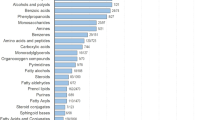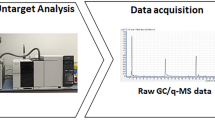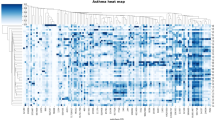Abstract
The analysis of volatile organic compounds (VOCs) within breath for noninvasive disease detection and monitoring is an emergent research field that has the potential to reshape current clinical practice. However, adoption of breath testing has been limited by a lack of standardization. This protocol provides a comprehensive workflow for online and offline breath analysis using selected ion flow tube mass spectrometry (SIFT-MS). Following the suggested protocol, 50 human breath samples can be analyzed and interpreted in <3 h. Key advantages of SIFT-MS are exploited, including the acquisition of real-time results and direct compound quantification without need for calibration curves. The protocol includes details of methods developed for targeted analysis of disease-specific VOCs, specifically short-chain fatty acids, aldehydes, phenols, alcohols and alkanes. A procedure to make custom breath collection bags is also described. This standardized protocol for VOC analysis using SIFT-MS is intended to provide a basis for wider application and the use of breath analysis in clinical studies.
This is a preview of subscription content, access via your institution
Access options
Access Nature and 54 other Nature Portfolio journals
Get Nature+, our best-value online-access subscription
$29.99 / 30 days
cancel any time
Subscribe to this journal
Receive 12 print issues and online access
$259.00 per year
only $21.58 per issue
Buy this article
- Purchase on Springer Link
- Instant access to full article PDF
Prices may be subject to local taxes which are calculated during checkout





Similar content being viewed by others
References
European Parliament and the Council of 21 April 2004. Emissions of volatile organic compounds in paints, varnishes and vehicle refinishing products. https://eur-lex.europa.eu/legal-content/EN/TXT/?uri=CELEX%3A32004L0042 (2004).
Spanel, P. & Smith, D. Progress in SIFT-MS: breath analysis and other applications. Mass Spectrom. Rev. 30, 236–267 (2011).
Smith, D. & Španěl, P. On the importance of accurate quantification of individual volatile metabolites in exhaled breath. J. Breath Res. 11, 047106 (2017).
Markar, S. R. et al. Assessment of a noninvasive exhaled breath test for the diagnosis of oesophagogastric cancer. JAMA Oncol. 4, 970–976 (2018).
Vadhwana, B. et al. Impact of oral cleansing strategies on exhaled volatile organic compound levels. Rapid Commun. Mass Spectrom. https://doi.org/10.1002/rcm.8706 (2019).
Oakley-Girvan, I. & Davis, S. W. Breath based volatile organic compounds in the detection of breast, lung, and colorectal cancers: a systematic review. Cancer Biomark. 21, 29–39 (2017).
Pauling, L., Robinson, A. B., Teranishi, R. & Cary, P. Quantitative analysis of urine vapor and breath by gas-liquid partition chromatography. Proc. Natl Acad. Sci. USA 68, 2374–2376 (1971).
de Lacy Costello, B. et al. A review of the volatiles from the healthy human body. J. Breath. Res. 8, 014001 (2014).
Schleich, F. N. et al. Exhaled volatile organic compounds are able to discriminate between neutrophilic and eosinophilic asthma. Am. J. Respir. Crit. Care Med. 200, 444–453 (2019).
Fowler, S. J., Basanta-Sanchez, M., Xu, Y., Goodacre, R. & Dark, P. M. Surveillance for lower airway pathogens in mechanically ventilated patients by metabolomic analysis of exhaled breath: a case-control study. Thorax 70, 320–325 (2015).
Woodfield, G. et al. Feasibility and acceptability of breath research in primary care: a prospective, cross-sectional, observational study. BMJ Open 11, e044691 (2021).
Henderson, B. et al. A benchmarking protocol for breath analysis: the peppermint experiment. J. Breath. Res. 14, 046008 (2020).
Hanna, G. B., Boshier, P. R., Markar, S. R. & Romano, A. Accuracy and methodologic challenges of volatile organic compound-based exhaled breath tests for cancer diagnosis: a systematic review and meta-analysis. JAMA Oncol. 5, e182815 (2019).
Aksenov, A. A. et al. Auto-deconvolution and molecular networking of gas chromatography–mass spectrometry data. Nat. Biotechnol. 39, 169–173 (2021).
Biagini, D. et al. Determination of volatile organic compounds in exhaled breath of heart failure patients by needle trap micro-extraction coupled with gas chromatography-tandem mass spectrometry. J. Breath. Res. 11, 047110 (2017).
Bruderer, T. et al. On-line analysis of exhaled breath focus review. Chem. Rev. 119, 10803–10828 (2019).
Smith, D. & Spanel, P. Direct, rapid quantitative analyses of BVOCs using SIFT-MS and PTR-MS obviating sample collection. Trends Anal. Chem. 30, 945–959 (2011).
Wiley Science Solutions. NIST/EPA/NIH Mass Spectral Library 2020. https://sciencesolutions.wiley.com/solutions/technique/gc-ms/nist-epa-nih-mass-spectral-library-2020-2/
Wiley Science Solutions. Wiley Registry of Mass Spectral Data, 12th Edition. https://sciencesolutions.wiley.com/solutions/technique/gc-ms/wiley-registry-of-mass-spectral-data-12th-edition/
Chin, S. T., Romano, A., Doran, S. L. F. & Hanna, G. B. Cross-platform mass spectrometry annotation in breathomics of oesophageal-gastric cancer. Sci. Rep. 8, 5139 (2018).
Martinez-Lozano, P., Rus, J., Fernandez de la Mora, G., Hernandez, M. & Fernandez de la Mora, J. Secondary electrospray ionization (SESI) of ambient vapors for explosive detection at concentrations below parts per trillion. J. Am. Soc. Mass Spectrom. 20, 287–294 (2009).
Montuschi, P., Mores, N., Trove, A., Mondino, C. & Barnes, P. J. The electronic nose in respiratory medicine. Respiration 85, 72–84 (2013).
Behera, B., Joshi, R., Anil Vishnu, G. K., Bhalerao, S. & Pandya, H. J. Electronic nose: a non-invasive technology for breath analysis of diabetes and lung cancer patients. J. Breath. Res. 13, 024001 (2019).
Costanzo, M. T. et al. Portable FAIMS: applications and future perspectives. Int. J. Mass Spectrom. 422, 188–196 (2017).
Covington, J. A. et al. The application of FAIMS gas analysis in medical diagnostics. Analyst 140, 6775–6781 (2015).
Gonzalez-Cortes, J. J., Bruneel, J., Ramirez, M. & Walgraeve, C. Effect of hydrophobic fumed silica addition on a biofilter for pentane removal using SIFT-MS. Chemosphere 254, 126738 (2020).
Smith, D., Cheng, P. & Spanel, P. Analysis of petrol and diesel vapour and vehicle engine exhaust gases using selected ion flow tube mass spectrometry. Rapid Commun. Mass Spectrom. 16, 1124–1134 (2002).
Spanel, P. & Smith, D. Quantification of volatile metabolites in exhaled breath by selected ion flow tube mass spectrometry, SIFT-MS. Clin. Mass Spectrom. 16, 18–24 (2020).
Langford, V. S., Padayachee, D., McEwan, M. J. & Barringer, S. A. Comprehensive odorant analysis for on-line applications using selected ion flow tube mass spectrometry (SIFT-MS). Flavour Fragr. J. 34, 393–410 (2019).
La Nasa, J. et al. SIFT-ing archaeological artifacts: selected ion flow tube-mass spectrometry as a new tool in archaeometry. Talanta 207, 120323 (2020).
Smith, D., Spanel, P., Herbig, J. & Beauchamp, J. Mass spectrometry for real-time quantitative breath analysis. J. Breath. Res. 8, 027101 (2014).
Smith, D. & Spanel, P. Status of selected ion flow tube MS: accomplishments and challenges in breath analysis and other areas. Bioanalysis 8, 1183–1201 (2016).
Smith, D., McEwan, M. J. & Spanel, P. Understanding gas phase ion chemistry is the key to reliable selected ion flow tube-mass spectrometry analyses. Anal. Chem. 92, 12750–12762 (2020).
Spanel, P., Dryahina, K. & Smith, D. A general method for the calculation of absolute trace gas concentrations in air and breath from selected ion flow tube mass spectrometry data. Int. J. Mass Spectrom. 249, 230–239 (2006).
Spanel, P., Ji, Y. F. & Smith, D. SIFT studies of the reactions of H3O+, NO+ and O-2(+) with a series of aldehydes and ketones. Int. J. Mass Spectrom. 165, 25–37 (1997).
Lawal, O., Ahmed, W. M., Nijsen, T. M. E., Goodacre, R. & Fowler, S. J. Exhaled breath analysis: a review of ‘breath-taking’ methods for off-line analysis. Metabolomics 13, 110 (2017).
Doran, S. L. F., Romano, A. & Hanna, G. B. Optimisation of sampling parameters for standardised exhaled breath sampling. J. Breath. Res. 12, 016007 (2017).
Boshier, P. R. et al. On-line, real time monitoring of exhaled trace gases by SIFT-MS in the perioperative setting: a feasibility study. Analyst 136, 3233–3237 (2011).
Adam, M. E. et al. Mass-spectrometry analysis of mixed-breath, isolated-bronchial-breath, and gastric-endoluminal-air volatile fatty acids in esophagogastric cancer. Anal. Chem. 91, 3740–3746 (2019).
Ghimenti, S. et al. Comparison of sampling bags for the analysis of volatile organic compounds in breath. J. Breath. Res. 9, 047110 (2015).
Brůhová Michalčíková, R., Dryahina, K., Smith, D. & Španěl, P. Volatile compounds released by Nalophan; implications for selected ion flow tube mass spectrometry and other chemical ionisation mass spectrometry analytical methods. Rapid Commun. Mass Spectrom. https://doi.org/10.1002/rcm.8602 (2019).
Horváth, I. et al. A European Respiratory Society technical standard: exhaled biomarkers in lung disease. Eur. Respir. J. 49, https://doi.org/10.1183/13993003.00965-2016 (2017).
Blanchet, L. et al. Factors that influence the volatile organic compound content in human breath. J. Breath. Res. 11, 016013 (2017).
Agarwal, A. R., Yin, F. & Cadenas, E. Short-term cigarette smoke exposure leads to metabolic alterations in lung alveolar cells. Am. J. Respir. Cell Mol. Biol. 51, 284–293 (2014).
Capone, S. et al. Chromatographic analysis of VOC patterns in exhaled breath from smokers and nonsmokers. Biomed. Chromatogr. https://doi.org/10.1002/bmc.4132 (2017).
Ajibola, O. A., Smith, D., Spanel, P. & Ferns, G. A. Effects of dietary nutrients on volatile breath metabolites. J. Nutr. Sci. 2, e34 (2013).
Baranska, A. et al. Profile of volatile organic compounds in exhaled breath changes as a result of gluten-free diet. J. Breath. Res. 7, 037104 (2013).
Smith, D., Spanel, P. & Davies, S. Trace gases in breath of healthy volunteers when fasting and after a protein-calorie meal: a preliminary study. J. Appl. Physiol. (1985) 87, 1584–1588 (1999).
Bovey, F. et al. Breath acetone as a marker of energy balance: an exploratory study in healthy humans. Nutr. Diabetes 8, 50 (2018).
Heaney, L. M. & Lindley, M. R. Translation of exhaled breath volatile analyses to sport and exercise applications. Metabolomics 13, 139 (2017).
Decombaz, J. et al. Effect of short-duration lipid supplementation on fat oxidation during exercise and cycling performance. Appl. Physiol. Nutr. Metab. 38, 766–772 (2013).
Couto, M. et al. Oxidative stress in asthmatic and non-asthmatic adolescent swimmers— a breathomics approach. Pediatr. Allergy Immunol. 28, 452–457 (2017).
Turner, C., Spanel, P. & Smith, D. A longitudinal study of ammonia, acetone and propanol in the exhaled breath of 30 subjects using selected ion flow tube mass spectrometry, SIFT-MS. Physiol. Meas. 27, 321–337 (2006).
Phillips, M., Greenberg, J. & Sabas, M. Alveolar gradient of pentane in normal human breath. Free Radic. Res. 20, 333–337 (1994).
Spanel, P., Dryahina, K. & Smith, D. A quantitative study of the influence of inhaled compounds on their concentrations in exhaled breath. J. Breath. Res. 7, 017106 (2013).
Harshman, S. W. et al. Characterization of standardized breath sampling for off-line field use. J. Breath. Res. 14, 016009 (2019).
Want, E. J. et al. Global metabolic profiling of animal and human tissues via UPLC-MS. Nat. Protoc. 8, 17–32 (2013).
Want, E. J. et al. Global metabolic profiling procedures for urine using UPLC-MS. Nat. Protoc. 5, 1005–1018 (2010).
Trefz, P., Schubert, J. K. & Miekisch, W. Effects of humidity, CO2 and O2 on real-time quantitation of breath biomarkers by means of PTR-ToF-MS. J. Breath. Res. 12, 026016 (2018).
Kumar, S. et al. Selected ion flow tube mass spectrometry analysis of exhaled breath for volatile organic compound profiling of esophago-gastric cancer. Anal. Chem. 85, 6121–6128 (2013).
Slingers, G. et al. Real-time selected ion flow tube mass spectrometry to assess short- and long-term variability in oral and nasal breath. J. Breath. Res. 14, 036006 (2020).
Boshier, P. R., Marczin, N. & Hanna, G. B. Repeatability of the measurement of exhaled volatile metabolites using selected ion flow tube mass spectrometry. J. Am. Soc. Mass Spectrom. 21, 1070–1074 (2010).
Boshier, P. R., Cushnir, J. R., Priest, O. H., Marczin, N. & Hanna, G. B. Variation in the levels of volatile trace gases within three hospital environments: implications for clinical breath testing. J. Breath. Res. 4, 031001 (2010).
Manolis, A. The diagnostic potential of breath analysis. Clin. Chem. 29, 5–15 (1983).
Acknowledgements
The authors acknowledge Q. Wen for figure editing and E. Want for her kind support and precious advice. P.R.B. and S.R.M. are supported by National Institute for Health Research (NIHR) lectureships. I.B. and A.M. are supported by Rosetrees and Stonygates Trusts and NIHR London In Vitro Diagnostics Co-operative. This research was supported by the NIHR Diagnostic Evidence Co-operative London at Imperial College Healthcare NHS Trust. The views expressed are those of the authors and not necessarily those of the National Health Service, the NIHR or the Department of Health.
Author information
Authors and Affiliations
Contributions
All the authors discussed the design of the manuscript. I.B., P.R.B., B.V. and S.R.M. carried out the experiments. I.B., P.R.B., A.M. and B.V. wrote the original draft of the manuscript. P.S. and G.B.H. supervised the projects and revised the manuscript.
Corresponding author
Ethics declarations
Competing interests
G.B.H. is the founder of VODCA Limited, a company for early detection of cancer.
Additional information
Peer review information Nature Protocols thanks James Covington, Jean François Focant, Gudrun Koppen and the other, anonymous reviewer(s) for their contribution to the peer review of this work.
Publisher’s note Springer Nature remains neutral with regard to jurisdictional claims in published maps and institutional affiliations.
Related links
Key references using this protocol
Markar, S. R. et al. JAMA Oncol. 4, 970-976 (2018): https://doi.org/10.1001/jamaoncol.2018.0991
Vadhwana, B. et al. Rapid Commun. Mass Spectrom. 34, e8706 (2019): https://doi.org/10.1002/rcm.8706
Key data used in this protocol
Markar, S. R. et al. JAMA Oncol. 4, 970-976 (2018): https://doi.org/10.1001/jamaoncol.2018.0991
Supplementary information
Supplementary Information
Supplementary Note 1 and Supplementary Tables 1 and 2.
Rights and permissions
About this article
Cite this article
Belluomo, I., Boshier, P.R., Myridakis, A. et al. Selected ion flow tube mass spectrometry for targeted analysis of volatile organic compounds in human breath. Nat Protoc 16, 3419–3438 (2021). https://doi.org/10.1038/s41596-021-00542-0
Received:
Accepted:
Published:
Issue Date:
DOI: https://doi.org/10.1038/s41596-021-00542-0
This article is cited by
-
Volatilomes of human infection
Analytical and Bioanalytical Chemistry (2024)
-
Variation of volatile organic compound levels within ambient room air and its impact upon the standardisation of breath sampling
Scientific Reports (2022)
Comments
By submitting a comment you agree to abide by our Terms and Community Guidelines. If you find something abusive or that does not comply with our terms or guidelines please flag it as inappropriate.



